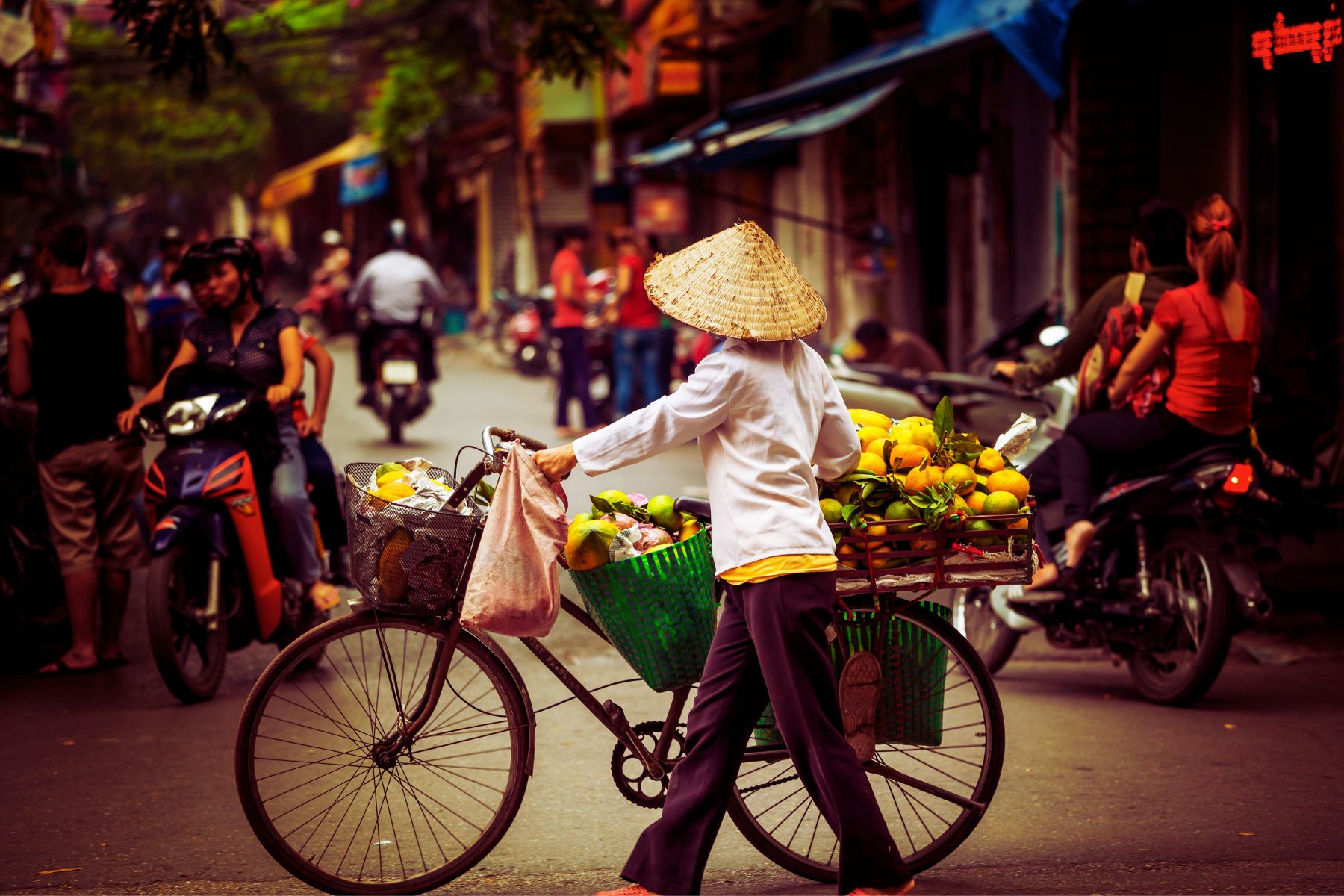
Can you see Vietnam’s vast collection of curiosities, sights and delights in just three weeks? In short…no…you can’t.
But as I’ve recently found out, you can certainly get a taste of this vibrant slice of South East Asia in 21 days. So if it’s financially viable for you and you’re after an Asian adventure, I’d urge you to do so.
I must add at this point, it probably wasn’t financially viable for me. I sold my car to finance this trip; that’s what winter in England will do to a man.
However, as I stand here typing this on my phone, standing at the bus stop in the cold, the drizzling rain running down my well-tanned face, I can honestly say I don’t regret a thing… apart from maybe not bringing an umbrella.
Travel is always enlightening, food for the soul as they say, and Asia might be the most gluttonous of all the travelling feasts, a sensory all-you-can-eat buffet.
Although three weeks probably isn’t enough to gorge on it all, you can certainly give the waistband a good stretching. I most definitely did (in a metaphorical and a literal sense), and this is what I learned.
Pack for the Weather

I left London with a spring in my step, and twenty-six hours and three flights later, I arrived in Hanoi. Again, I must stress this trip probably wasn’t financially viable for me, which is why I booked the cheapest and most indirect flight Skyscanner had to offer.
Stepping off the plane, I expected that holiday warmth, which would make the whole travelling ordeal worthwhile, but I discovered it was actually quite chilly.
I had travelled with only hand luggage, swim shorts, t-shirts and bucket hats, making up the bulk of that. It wasn’t long before I realised that my classic Brit-abroad attire wouldn’t just result in me looking like a bit of a nobhead, but it might actually be detrimental to my health.
I was forced to buy trousers and a fleece within hours of landing. I’d advise doing a little more research than I did, and you probably don’t need a travel magazine to tell you this, but pack accordingly. The North and South vary massively in their temperatures and climates.
Vietnam is Big
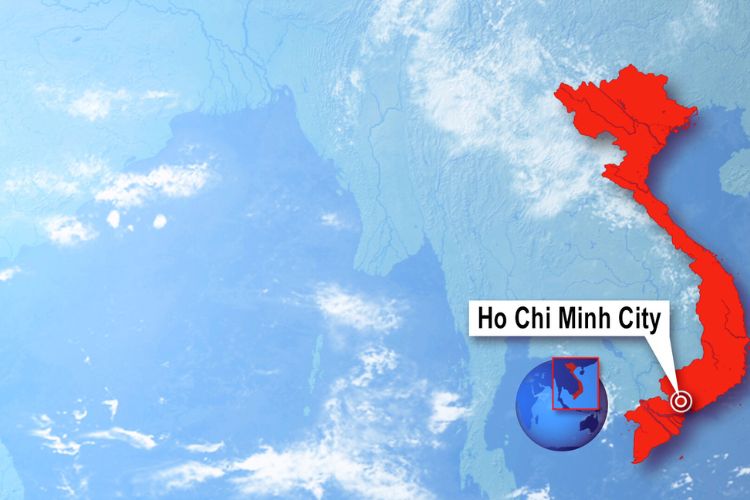
The country of Vietnam is bigger than you might think. I didn’t fully comprehend this when I booked my cheap flight into Hanoi (the capital in the north) and returned out of Ho Chi Minh, formerly Saigon (the south).
As I said, I hadn’t exactly planned this trip. I sold the car, booked a flight and thought once we were done in the north, I’d hop on a moped and poodle on down to Ho Chi Minh at a leisurely pace, stopping along the way whenever we so pleased. However, Vietnam is a long country.
The two cities are 995 miles apart. That’s the equivalent of London to Inverness and back. You wouldn’t fancy that on a 50 cc moped in the middle of February, would you?
Luckily, due to the spontaneous nature of the trip, we didn’t actually have anything planned, so we could adapt the route and mode of transport according to our mood. Funnily enough, our mood didn’t fancy a 1000-mile road trip on scooters.
Having a detailed itinerary works for some, but I’d strongly advise that freedom is king when travelling, and set plans can detract from that sense of adventure. The only thing I did pre-book was a bit of luxury. As it turns out, that luxury, despite being affordable, was still costly.
Luxury in Asia is Affordable
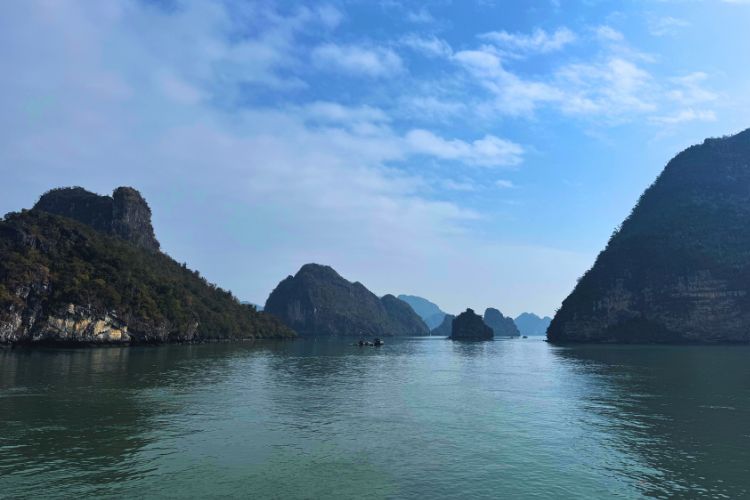
The one bit of accommodation I pre-booked before landing in Vietnam was an outlandish one—a luxury cruise to Halong Bay . A UNESCO spot where limestone structures pierce through the emerald green waters in striking fashion.
There are hundreds of options when booking a tour of this mystical sight, from small fishing boats to luxury yachts and full-on fancy cruise ships. I opted for the latter, but this is limiting.
The cruise ships all provide a very similar itinerary that may include kayaking, swimming, tai chi and fishing classes. Some also include a biking trip around Cat Ba Island.
Cat Ba is an island within Halong Bay where we were told we could spy on locals as they went about their daily lives. On arrival, it became clear it wasn’t quite as sold.
It was a tourist trap where the ‘local’ village reminded me of a caravan park with the sole purpose of selling tourists fish pedicures, snake wine and other delicacies.
However, the cruises do all this by picking up passengers from smaller ships and ferrying them around. The big cruise ships barely move during the three-day cruise, so really, it’s just like being on a floating hotel.
If you were to book a smaller boat, you’d no doubt see a lot more of the 600 square miles of 1,600 limestone islets, while I imagine getting a little more of an authentic experience.
So, although the luxury cruise ship is extremely affordable by Western standards (two nights and three days of extreme luxury range from £300 – £800), it’s costly in other ways, i.e., having a generic mass rolled-out type of experience.
Some Things are Costly
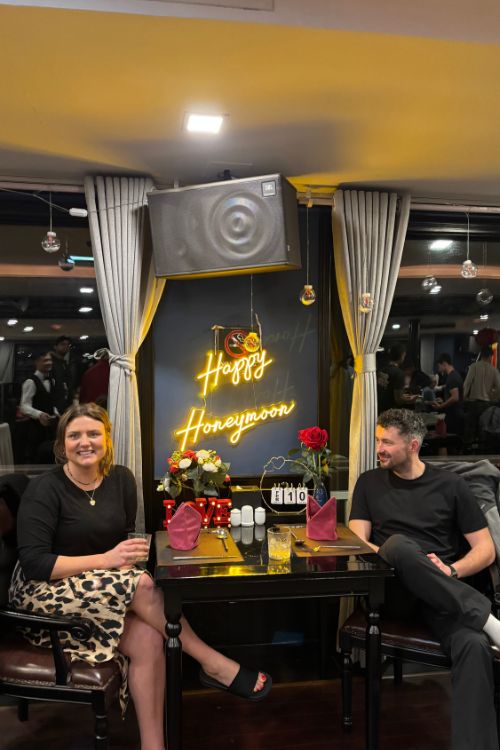
In our case, it was costly in a unique way. I was feeling the effects of the night before when booking the cruise, and I felt like I needed a serotonin boost, so I opted for the honeymoon suite for myself and my partner.
We’re not married; we’ve only been seeing each other for a couple of months. Playing up to the ‘honeymoon suite’ thing, I emailed the cruise ship almost daily, telling them how much we were looking forward to our special honeymoon and how we were so busy planning our ‘fictional’ wedding.
The point of this correspondence was mainly to make my partner laugh but also to plant the seed for some honeymoon freebies. I was thinking champagne, cocktails, something fancy and fitting for such an occasion.
Sadly, the freebies didn’t arrive, bar a disgusting bottle of red ‘wine’. What did arrive, though, was one of the most embarrassing moments of our lives.
On the final evening of the cruise, when the dining room was at its fullest, the lights dimmed, and the entire crew emerged, led by a waitress holding a candlelit cake.
At first, we assumed there was a birthday on board. The crew circled the buffet bar not twice but three times, just to ensure absolutely everyone was watching them. Then, to our disgust, dismay and shame, the parade started marching towards our table.
They proceeded to serenade us with a bizarre happy honeymoon song as the entire cruise ship watched on, clapped and congratulated us on our ‘marriage’.
So yes, luxury is affordable in Asia, but lying, especially about marriage, is very costly.
Embrace the Homestays
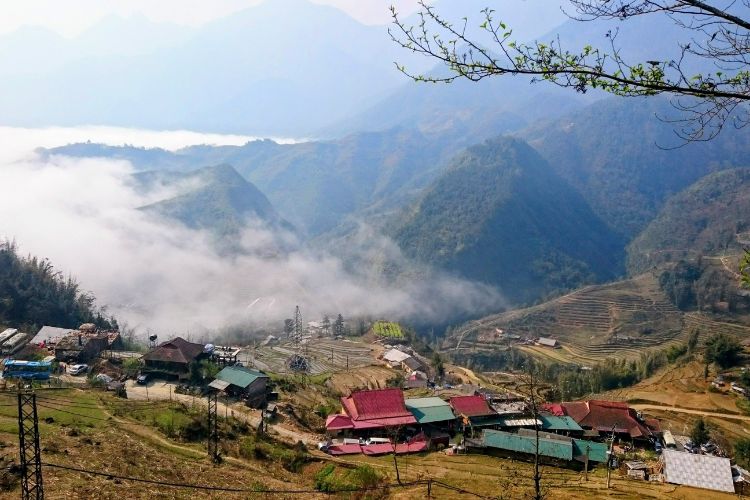
The weather, the lovely food, and the lovelier people were among the top reasons why travelers whom I’d spoken to recommended Vietnam so highly. Two of those factors were abundant during my stay in the north of Vietnam.
Another common theme among the praise for Vietnam was the northern region, the rustic beauty of the rice paddies, and the serenity of Sapa.
If it wasn’t for these endorsements, I may have been tempted to bypass Sapa and head south as it’s a bit of a slog to get to from Hanoi. The journey was 200 miles and seven hours of windy hill roads—but it was definitely worth the effort.
I went from a luxury honeymoon suite on a warm cruise ship complete with a balcony and a bathtub to a tin shack where I slept fully clothed and beneath four rugs.
I no longer had to fear being serenaded by an entire crew of a cruise ship who thought it was my honeymoon with cake and a strange rendition of a honeymoon song.
Instead, in my new accommodation, I was serenaded by chickens, dogs and even buffalo every morning, all of whom I had to tiptoe past on the way to the outside toilet.
In the northern regions, hotels are not commonplace. Homestays are where more intrepid tourists tend to lay their tired heads after long walks with a local guide. Luxurious they are not, but the hospitality and authenticity more than make up for things like central heating and indoor toilets.
Rise of Tourism
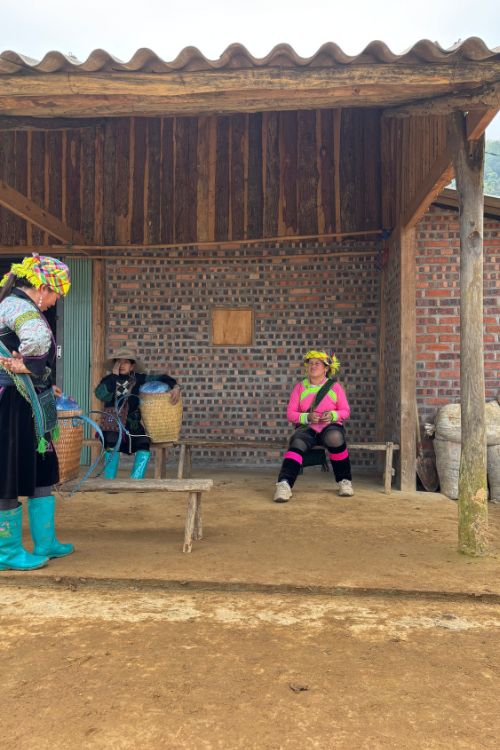
Our host was a wonderful, joyous woman called Chi. She was an inspiring little figure who had taught herself English not by the education she received from the state but by talking to the tourists she had encountered in her youth.
While trekking up a windy, boggy, near-vertical rice paddy, Chi told how the village of Lao Chai had changed dramatically since she was a young girl.
The massive rise of tourism has greatly altered the village’s nature and economy; however, Chi feels as if it’s for the better.
The homestay hosts tailor the tours to the guests’ fitness levels and duration of stay. Along the way, you’ll learn of local customs that are as memorable as the sights themselves, if not more so, if you get the same damp, misty weather I encountered.
Unusual Courtship
Chi informed us of the traditional courting process whereby if a man liked a woman, he would ‘kidnap’ her.
This involved physically dragging her to his house, against her will, where she would live for a few days as a part of the family, getting on with the chores—all so they could get to know each other. Talk about a bad first date.
‘Where did he take you?’ I inquired.
“Oh, you know his tin shack,” she replied.
Me: “Right… did you do anything nice?”
She responded humorously, “Errm, well, I’ve got to do the washing up and help him feed his chickens.”
It sounds pretty horrific by modern standards, but Chi laughed it off, saying, “It’s just tradition.” She also added that she was kidnapped three times before finding her husband.
We learned that the ‘kidnappings’ don’t happen anymore and that they were not violent in her case anyway; they were just a way of getting to know each other.
If the courting/kidnapping went well, the man’s family would be obliged to compensate the bride-to-be’s family with several litres of rice wine and a buffalo horn. To think that when you got married, you asked for a microwave reader. You missed a trick.
Folklore
Another nugget of local knowledge concerned a local tribe where all the women, to this day, shave the front of their heads.
The reason behind the look is that folklore dictates one woman, on the day of her wedding, cooked a delicious meal for her in-laws, but rather unfortunately, they both died choking on stray hairs that had fallen into the broth.
I did tell Chi there is a thing called hairnets, which have been invented since the origin of this tradition and that they are quite effective, but again she laughed it off as ‘tradition’.
No one likes finding a hair on their plate, do they? But you’d feel a bit guilty if you were in a restaurant, found a hair in your carbonara, informed the waiter, who proceeded to bring out the chef and scalp him or her tableside, wouldn’t you?
Roles Have Changed
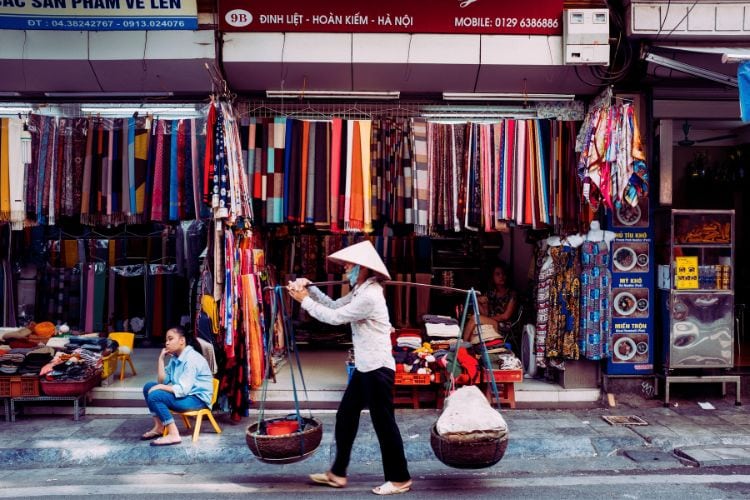
I think it’s fair to say that women had it hard in the northern tribes of Vietnam, but times have changed, and they are now the breadwinners.
Chi is not alone when it comes to women who have taught themselves English and provide homestays and tours. By doing so, they provide for their families, whilst a lot of the time, the men stay home, look after the children, rear the animals and take care of the house and land.
Another great thing about the homestays is that guests return to their host families every evening after the long hikes through the boggy, misty hills (again, hopefully, you’ll get better weather than I). Here you’re wined and dined, or should I say, rice-wined and dined.
Rice wine is referred to as Happy Water. Although the taste of it will not make you happy, it is as intoxicating as the people are friendly, and the home-cooked meals are delicious here in the north.
Motorbikes in Vietnam Aren’t for Beginners
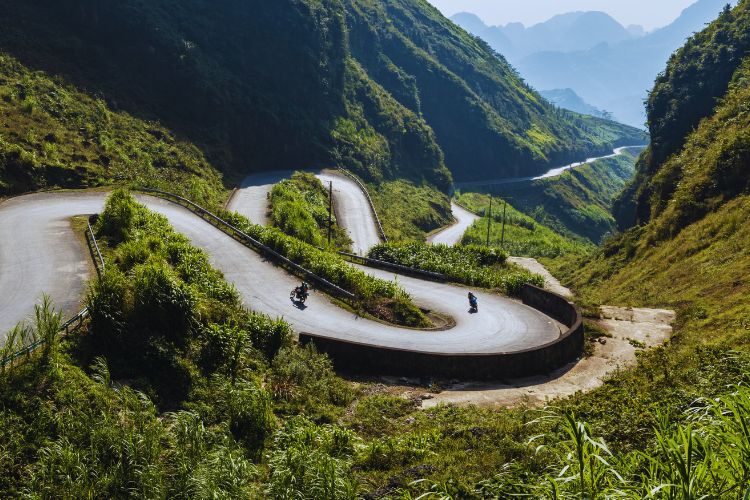
The north is a popular destination for bikers and adventurers who like to whizz around on two wheels. The views from the mountainous, narrow roads are (as I’ve seen on Instagram) breathtaking.
The Ha Giang loop is a must for daredevils and bike-lovers. One evening, I asked Chi if I could use her husband’s motorbike. She naturally obliged and asked if I’d ever driven a scooter with a manual clutch. I replied confidently, ‘Of course.’ I absolutely hadn’t, but I figured, how hard can it be….? It turns out to be quite hard and quite terrifying.
I had my ‘wife’ on the back of the scooter, and despite the newlywed romance being as thick as the Sapa cloud in the air, after ten nerve-wracking minutes, she demanded that I pull over so she could walk.
So yeah, I recommend a homestay in the north as an absolute must; you can learn so much from the locals, but maybe learning to ride one of their scooters on near-vertical roads is not the best bet.
Ha Giang Loop Motorbike Tour
The Scooter is King
It’s no secret that here in Asia, the scooter is king, and it’s easy to see why. It’s an extremely cost-efficient and easy-to-use mode of transport.
Although you wouldn’t say that if you’d seen me nervously swerving around buffalo, avoiding potholes the size of craters and struggling to shift gear while reassuring my beloved that we weren’t, in fact, going to die. However, to the average Vietnamese person, it’s incredibly effortless.
As a westerner in Hanoi and Ho Chi Minh, I think it’s almost impossible not to be alarmed by the chorus of beeps and horns. The horn in England is only ever really deployed when someone has really angered you by pulling out on you and you want them to know what a twit you think they are.
Here in Vietnam, it’s used as a friendly reminder, ‘I’m here, friend’ as opposed to ‘you idiot, you mildly inconvenienced my day, and I want you to know about it’. The beeps are relentless, though, and the sheer volume of scooters on any given city street is frankly extraordinary.
Organized Chaos
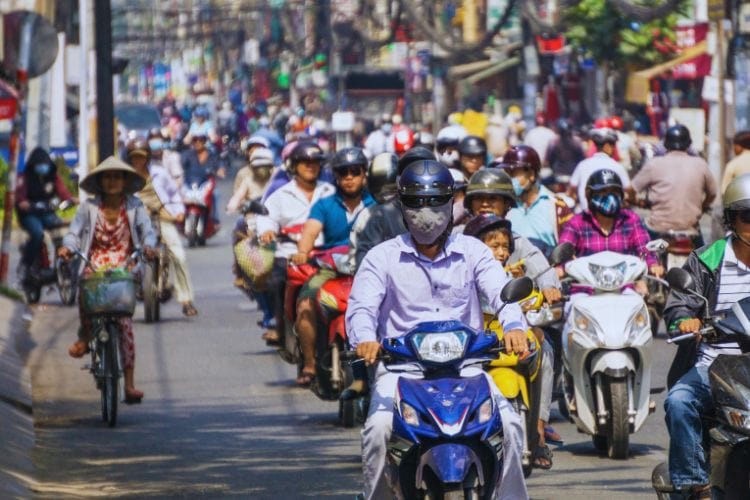
It’s quite a daunting task as a pedestrian to navigate through an oncoming army of mopeds, some carrying two people, some three, some a whole shop. You even see them carrying a tree or the most cardboard boxes you’ve ever seen in your life.
It’s madness, as not only are the scooters seemingly overloaded, but they don’t stop for you. The confidence and effortless bravado that they all seem to have is a sight to behold.
I was speaking to a local at a restaurant in Hanoi, and I asked him: “Do you see many crashes here?”
He answered quite poetically, “You have to think of the whole city as an organism, and although it might all look mad and chaotic, it works. The chaos works”.
Vietnam Tours & Excursions
Grab a Grab
The best way to feel the functional chaos firsthand is by jumping on the back of a Grab. It’s the Asian equivalent of Uber, and it’s without a doubt the best way to get around a busy city.
You’ll be picked up by a man who will hand you a green helmet, and you’ll jump on the back of his moped, initially clinging on for dear life itself as he weaves effortlessly through traffic.
That worry will soon dissipate, though, as you soon come to the realization that he is, in fact, like every grab driver and moped driver in Vietnam, a wizard.
If life had played him a kinder hand, he could be rivalling Lewis Hamilton around a track in Monaco… but instead, he’s dropping you at a bar at 11:30 AM on a Tuesday.
The long-winded point being you’ll be in safe hands. If you don’t believe me, watch the locals on the back of their grabs.
Most are texting, some smoking, some watching YouTube videos. None are remotely concerned about being part of the chaos because here, the scooter is king.
Keep Moving

It’s important, as a ‘travel writer,’ that I stress the need to keep moving. That’s not just in terms of crossing the average road in any given city, where you have to negotiate the army of mopeds approaching.
Your instinct is to stop when they approach, but the key is to keep moving, and that lesson applies to Vietnam as a whole. The place is such a feast for the senses and has so much to offer from the north to the very south, you’ve got to keep moving.
We didn’t stay anywhere for longer than two nights until the very end of the trip. With no pre-made plans, it was easy for us to decide a day before to jump on a sleeper bus from Sapa back to Hanoi or book an internal flight from Hanoi to Danang.
Tip: Don’t expect to sleep on a sleep bus—despite having a private cabin, you’ll be thrown around like a pair of trainers in a washing machine.
VIP Treatment is Not Out of Reach
On such an occasion, I booked what appeared to be the cheapest ticket but ended up with us getting celebrity treatment.
We were treated with a private taxi from the gate to the plane and access to the VIP lounge where I scoffed a few boiled eggs and swigged back red wine like a man who was convinced he’d be ejected any minute.
After landing and studying my purchase. It turned out I had, in my haste, bought the most expensive ticket available: Sky Boss with VietAir. If you’re a fan of a boiled egg, I’d thoroughly recommend it.
Hoi An is a Must
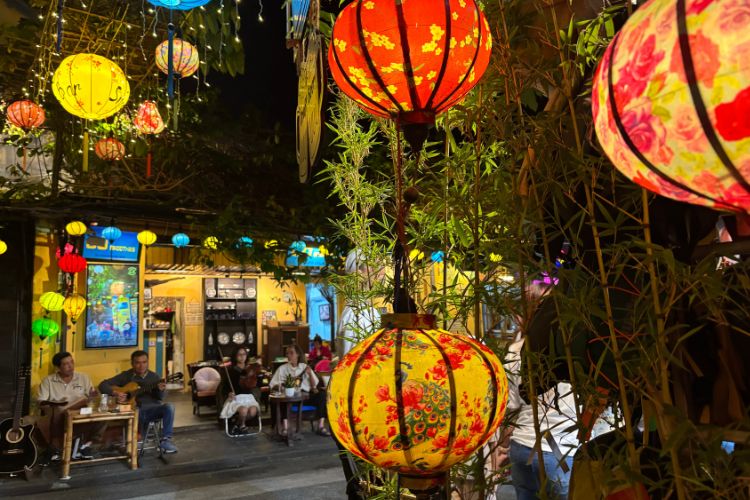
Even with that VIP flight, it’s so cheap to travel around Vietnam. From Danang, we took a taxi to Hoi An, which is one of the most beautiful and charming cities I’ve ever had the pleasure of swanning around in.
The lovely lantern-lit streets, shabby, decaying French architecture and colorful river boats will have you feeling quite romantic. If all that doesn’t do it for you, there’s a whole bar dedicated to Mr. Bean.
Read More: Exploring Vietnam’s Coastal City of Hoi An
Monkey Mafia
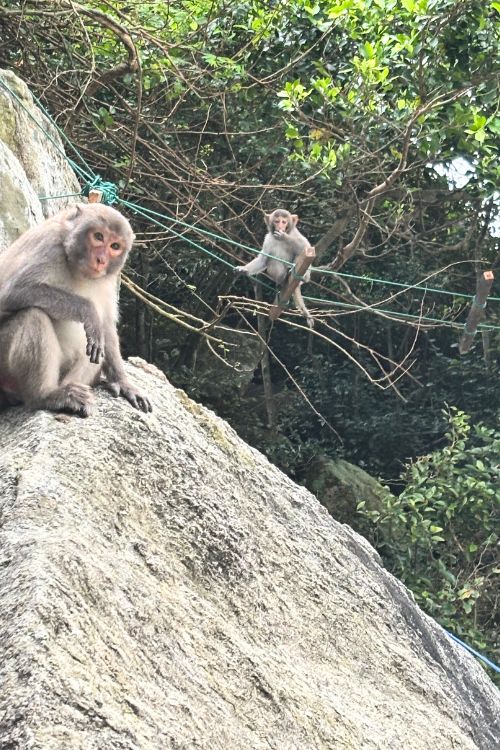
From there, we took a yellow mini, joking that it was a reference to Mr. Bean, and jumped on a speedboat to the Cham Islands.
The Islands present a serene, quiet pace of life where you can drift off whilst sunbathing on secluded beaches without a care in the world…well apart from the monkeys who will rummage through your bag given half a chance.
The monkeys run this island, as we found out first hand when they ransacked a restaurant in front of our very eyes. My instinct was to help the lady who was trying her utmost to shoo them away, but frankly, the sight was just too funny.
Once back on the mainland in Hoi An, before I’d managed to take off my shoes and bag them (as is the custom on the night buses of Vietnam), the bus had pulled away in frantic fashion.
There Will Be Sleepless Nights
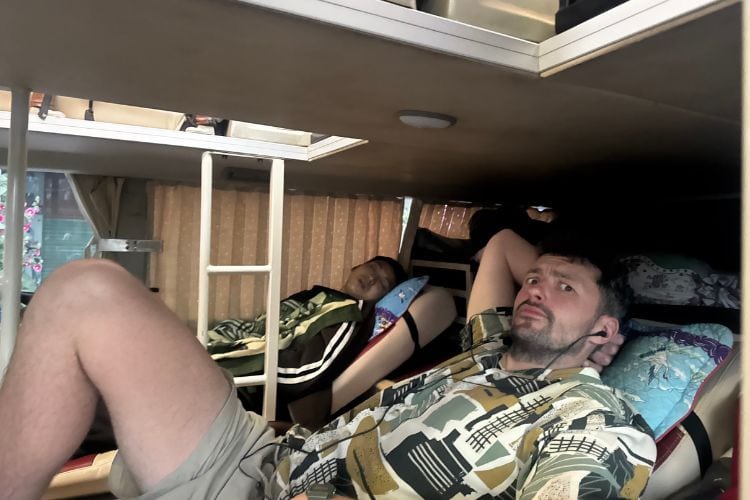
There were no private cabins this time around, just three rows of double-tier reclining seats. We were escorted to the very back row. I don’t suffer from car sickness, although on this journey, I did struggle.
Behind the back row of seats was a small coffin-like sleeping spot for tired members of staff, one of whom was having a lovely little snore-soundtracked snooze.
But that didn’t bother me; I’ve become quite accustomed to a heavy snorer these past few months, as it goes. Plus, everyone on this night bus was at it; there was a chorus of snoring loud enough to rival the beeps and horns of the scooters in the city centres.
No, what bothered me most was that this member of staff was snoring away behind me, barefoot. Despite constantly batting his little trotters away, they kept coming back in the direction of my face. I don’t want to paint a graphic picture of his toenails, but let’s just say they were unkempt.
That wasn’t the only nail-biting thing about the journey; these night bus drivers really do go for it, driving at speed while overtaking struggling diesel-chugging lorries on the hilly bends.
How the snoring chorus didn’t break for an interlude is beyond me, as again, I didn’t sleep a wink.
I made up for the lack of sleep in Nha Trang, where we found more secluded beaches and lauded it up between naps with lobster and lavish beach living.
River Themes
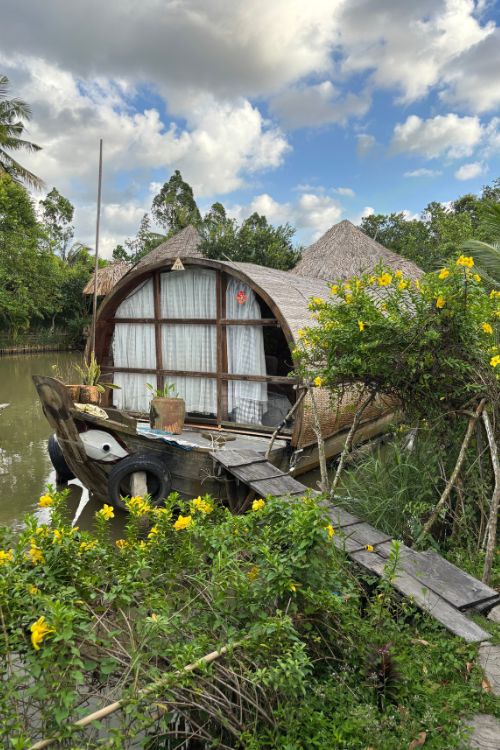
A few days later, we flew to Ho Chi Minh and took a taxi to Can Tho, a three-hour car journey which cost all of twenty-five British pounds. I’ve paid that for a 15-minute journey in the ungodly hours from regrettable rave to the haven of home.
Can Tho is the biggest city on the Mekong River, where tourists flock to marvel at the ‘traditional’ river markets. Playing up to the river theme, I booked a ‘romantic river stay’, a charming little boat (think Rosie and Jim) was to be our home for the next two nights.
However, slightly alarmingly, upon check-in, we were told the air con didn’t work, and no one had ever made it past two nights on the boat due to sea sickness. The boat did rock and sway and not in a newlywed kinda way.
Before going to sleep, we also noticed there was a gap on the sliding door, just the right size for a snake to slither through. Despite all of that, we slept like infants for four hours or so prior to being up before dawn to visit the markets.
Waking on our boat, we were shattered but delighted that we were alone on board, i.e., without a sea snake.
After a short walk along the river, we were met by our guide and boarded another boat—a noisy vessel that reminded me of my Ford Transit back home.
Chugging along the river in the night had an eerie quality to it. I couldn’t go as far as to say it was a relaxing cruise, as I was convinced every twig and floating log that peeked through the swampy Mekong was an alligator or a sea snake.
Floating Markets Sink

Some very brief research online will inform you that the best way to see the Can Tho market is by getting up early and hopping on a boat yourself. A private one is preferable, albeit a little more expensive.
As well as the main Cai Rang market, we opted to see the smaller market, Phong Dien first, as we read, it was quaint and charming and a little more localised. It was certainly little, about five or six boats huddled in the dark like a lost pack of penguins… animal, not the biscuit.
It wasn’t a breathtaking sight, dare I say it was a little underwhelming, but I bought myself a watermelon. We powered on to the Cai Rang floating market, which was far from little and, to be perfectly honest, felt about as authentic as a sweet and sour chicken ball.
It was a tourist factory. Small boats whizz around with similar vigour as the scooters in the city and were similarly overloaded, not with family members but with tourists.
The tour guide confirmed that this market isn’t used by local people anymore; it’s merely an attraction for the tourists before adding, “If you want a really good floating market, you should go to Thailand”.
After a brief trip to the ‘oldest rice factory’ in the Mekong region, we returned to our tour boat and started chugging our way back towards our night boat.
For the first time in the trip, there was a slight disappointment in the air. Maybe it was the swampy litter-filled river, maybe it was the fact we weren’t in Thailand visiting a genuine market, or maybe it was just the thought of returning to our potentially snake-infested rocking room.
Phu Quoc For the Win
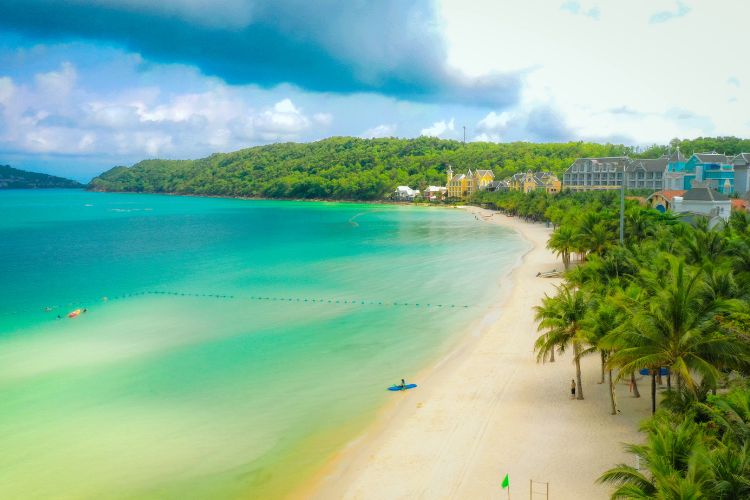
That’s when we asked the tour guide where she’d recommend us to go next, “Well, the island of Phu Quoc is really nice”.
I answered, “Yeah, I don’t really want to fly again, to be honest”.
She replied, “You can take the boat.”
“What, this one? No thanks,” is what I wanted to retort, but didn’t before she added, “The ferry only takes two hours.”
Within twenty-five minutes, we were packed, checked out, and in a taxi to the port.
Pho Quoc is paradise. The stereotypical Southeast Asian island is ludicrously beautiful and picturesque.
We found a great hotel where we stayed in a beachside cabin overlooking the clear blue sea; it felt as close to perfection as physically possible.
This paradise was where I tragically got food poisoning and spent the majority of our stay in the bathroom. But if you’re gonna get ill anywhere, I couldn’t recommend a better place than Phu Quoc.
It’s slightly ironic that it was in this luxury accommodation that the dreaded food poisoning reared its unwanted head. Prior to that, I had been gorging on street food, feasting in restaurants where the washing up is done in a bucket between the diners and the bathroom.
My advice to all is to keep moving… much like bowel movements in Phu Quoc, keep moving.
Worth the Price of a Car
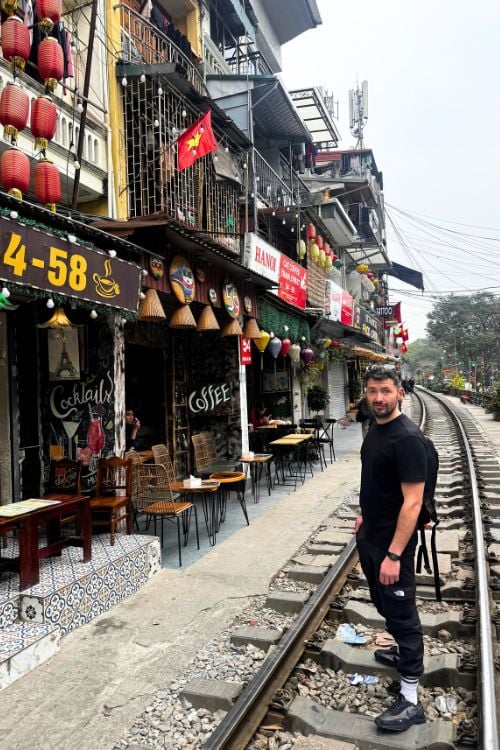
Vietnam is the only place in the world I can say it’s well worthwhile selling your car to go and visit… and truth be told, it doesn’t even have to be a good car… mine certainly wasn’t.
Once you’re there, it’s so cheap to live well, to eat well, and most importantly, drink well. For proof of Vietnam’s value for money, you can buy a beer for the equivalent of 10p.
You can laud it up here in luxury or scrimp your way through on a shoestring, and either way, you’ll gain so much from the trip. Gorging on the finest food, surrounded by extraordinary nature, curious culture, and welcomed by the cheeriest and most hospitable people along the way.
It certainly helped that I did it with a really special person by my side, a person who is as joyous as a sunrise, as daring as a Grab ride, as mischievous as the monkeys on Cham Island, as energetic as Vietnamese traffic, as warm as a bowl of morning pho and as lovely as that aforementioned 10p beer on a sun-soaked beach.
Vietnam is Simply Special

That’s not to say you need a special someone to enjoy this incredible place, as Vietnam is in itself special.
After just three weeks, I’m one of those annoying guys who will now be banging the visit Vietnam drum as loudly as any dude with a man bun or girl with hippie pants who’s ever visited.
I won’t go quite as far as to be eating every meal with chopsticks or insist on sitting on children’s garden furniture at every meal. I won’t be ferrying around my wife and family on the back of a scooter (for obvious reasons explained above), nor will I shoehorn Vietnam into every possible conversation.
Still, I will, when asked ‘What’s the favorite place you’ve visited?’, answer pretty swiftly, Vietnam—it’s special.
Inspire your next adventure with our articles below:
- The Magic of the Mekong Delta: From Vietnam to Cambodia by River Cruise
- Ultimate Guide to the Top 15 Things to Do in Vietnam
Author Bio: Dave McKenna is a comical columnist who writes for the Inews and the Margate Mercury as well as Community magazines. See Dave’s journey visually via his Instagram – @ave\_a\_nice\_dave
Want to discover more hidden gems and helpful travel tips? Join our free newsletter for the latest travel secrets and travel articles.
We are reader-supported and may earn a commission on purchases made through links in this article.
Originally published as From Honeymoon Hoaxes to Monkey Mafia: A 21-Day Journey Through Vietnam’s Sensory Feast on GoWorldTravel.com

